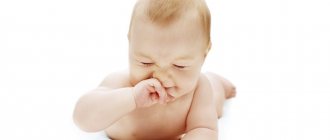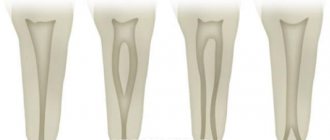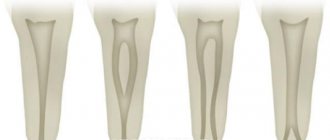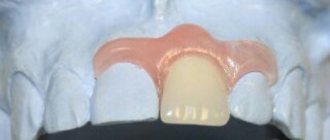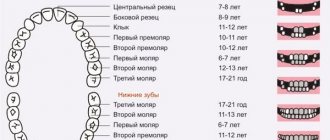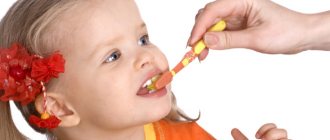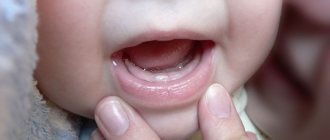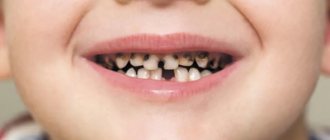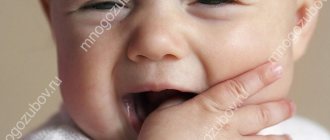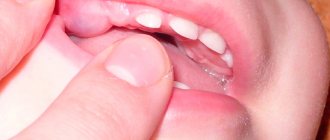How many teeth should a child have?
By the age of three, a child usually already has a full set of twenty primary teeth, and until about 6 years old, their number remains unchanged. Adolescents aged 13 to 18 years should normally have from 28 to 32 molars (depending on the presence of eights, which may erupt after 21 years or not appear at all).
Changing baby teeth to molars
Around the age of 4, a child’s growth spurt begins, the jaws enlarge and the baby teeth seem to move apart, with gaps appearing between them – trema. If this does not happen and by the age of 5 the teeth are still tight, you need to show the child to the dentist, as there may not be enough space for permanent teeth.
At about 5-6 years of age, baby teeth begin to become loose and gradually fall out, which indicates that the molars are already beginning to grow underneath them. Usually this process of change lasts for 5-8 years and the final formation of the dentition occurs somewhere around 14-15 years.
This happens in the following order:
- 5-6 years – lower and upper incisors.
- 7-8 years – lower and upper lateral incisors.
- 8-10 years – upper and lower molars.
- 9-11 years – upper and lower canines.
- 11-13 years – upper and lower molars.
Milk teeth are replaced by permanent molars. Their number at the age of 14-16 years is 28. At the same time, the third molars (wisdom teeth) are already formed, but they begin to grow only after 18 years. True, not all people grow them. It all depends on individual characteristics.
What teeth appear first in children?
The rudiments of baby teeth and even some molars begin to form at the stage of intrauterine development, so modern diagnostic technologies make it possible to track this process and prevent some deviations. After birth, the first teeth usually begin to erupt when the baby reaches six months of age. This means he will soon be ready to eat more solid foods. In the vast majority of cases, the incisors appear first: as a rule, the lower central incisor becomes the “pioneer”.
Useful tips
The root cause of diseases affecting the baby’s oral cavity is the incorrect actions of parents. To avoid problems such as caries, fluorosis, and enamel hypoplasia in the future, the following recommendations must be followed:
- For any abnormalities, make an appointment with your child to see a doctor.
- After teeth emerge, clean them with a special baby brush that fits on your finger.
- After 2 years, teach children to brush their teeth independently under adult supervision.
- For very small babies, brush their teeth with a weak soda solution or just with a damp brush. A 2-year-old child can brush his teeth using toothpaste.
- Buy a toothbrush according to your age group. The same goes for pasta.
- Brush your teeth with gentle movements without pressure.
- Choose fluoride-free baby toothpastes.
Folk remedy. You can gently clean children's teeth from pathogenic microflora with propolis infusion, a water-salt solution, or a decoction of sage or chamomile.
Child's front teeth
Since a child’s front teeth usually erupt earlier than the rest, they can be used to track how the baby’s body tolerates this process. It can occur in different ways: some children are practically not worried, while others, on the contrary, experience stress and discomfort. Swelling of the gums at the site of the future tooth, itching and pain, as well as a slight increase in temperature are the main negative aspects associated with the appearance of the first teeth. When teething baby molars, children may experience runny nose and cough.
Teething: how to help your baby
This may require a fair amount of patience. During such a difficult period, you should take the baby in your arms more often, caress him, distract him from unpleasant sensations with toys, turn on pleasant, soothing music, and you can sing if natural abilities allow. A walk in the fresh air can also have a calming effect. Children who are breastfed, during teething, begin to cry more often and ask for the breast, and a loving mother needs to be patient, putting the baby to the breast every time, even if he grabs the nipple areola harder than usual during feeding. To satisfy the child’s need to chew something and hold something in his mouth, you can naturally use special rubber rings or toys, so-called teethers. You can offer your child dry food or baby cookies.
Currently, pharmaceutical companies offer a wide range of different products, primarily in the form of gels to “soothe the gums.” In general, most of these products contain painkillers such as lidocaine. You should not abuse these funds. They are not completely harmless; the anesthetics they contain can have an adverse effect on the child’s nervous and cardiovascular systems, and most importantly, they can cause serious allergic symptoms and contribute to the exacerbation of atopic dermatitis (diathesis) in children prone to allergies. In connection with the above, I can recommend, to reduce swelling and inflammation of the gums during teething, such special dental anti-inflammatory drugs for topical use as Cholisal gel, which can be applied to the baby’s gums 2-3 times a day, but must be rubbed in (not too much). of course) with light massaging movements over the entire surface of the gums, and not just putting it in the child’s mouth.
In addition, you can give a child suffering from teething special homeopathic drops, for example Dantinorm baby, according to the instructions for the drug. In any case, if the disturbing symptoms described above in this article appear, I advise you to play it safe once again and call a pediatrician to the home of a child with a high fever. A professional should give his diagnosis and recommendations.
How do children's teeth grow?
There is no need to panic if the child’s teeth growth does not fit into the above scheme. A delay of 1 - 3 months is considered normal and is associated with the individual characteristics of the body. Children under one year of age often have teeth that do not appear on schedule or may not appear at all. In the latter case, you need to contact your dentist who will help identify the cause.
Eruption of second molars
The first fundamental units of the primary occlusion are the molars. They have the largest chewing area. They are diamond-shaped from above and cube-shaped from below. Children have 8 molars - two on each side below and above. The first molar and the second molar are distinguished. In terms of ranking from the central incisors, they occupy 4th and 5th positions. Their cutting order is as follows:
- the first in the lower jaw – 13-18 months;
- the first in the upper jaw – 14-19 months;
- the latter in the lower and upper jaws erupt approximately equally - at 23-31 months.
After a year, parents should prepare to meet these “guests”: the first to climb will be the one in the top row. By the age of two, the second ones appear. The correct sequence of appearance ensures a beautiful and correct bite. Many parents like to look into their babies' mouths and check how their teeth are coming in. You shouldn’t do this and worry the baby once again. Genetics plays a large role in this process.
There is no need to interfere: nature will take care of everything itself. A photo of molars will help you find out what chewing units look like. To help the child and alleviate his condition, it is very important for parents to know what the symptoms of teething are. Since the process occurs after a year, many children can already point to the sore spot and even say what they feel.
Tooth growth abnormalities in children
Unfortunately, the development and growth of teeth in children does not always occur as expected: there are a number of anomalies of various types that in one way or another affect the aesthetics and/or functionality of the teeth.
Causes of impaired growth and development of teeth:
- bad heredity;
- fetal injury during pregnancy or birth; intrauterine growth retardation, infections and so on;
- disruption of the endocrine system, thyroid dysfunction;
- lack of vitamins and minerals;
- mechanical, thermal and chemical injuries to teeth;
- bad habits in children that can affect the formation of teeth;
- lack of proper hygiene and poor diet.
Below is a table that describes the most common types of dental anomalies in children.
| Anomaly class | Description |
| Size of teeth | There are microdentia (too small teeth) and macrodentia (too large teeth). The anomaly can affect one or several teeth (and even the entire dentition). |
| Number of teeth | There is partial (lack of several teeth) and complete (absence of all teeth) adentia. Hyperdentia is a supernumerary set of teeth (usually in the second row). |
| Shape of teeth | Cone-shaped, barrel-shaped (Hutchinson's teeth), Pflueger's teeth (the neck is more developed than the coronal part). |
| Anomalies in the structure of enamel and dentin | Hypoplasia (spots and grooves on the body of the tooth), hyperplasia (tubercles, enamel drops, etc.), dentinogenesis imperfecta (violation of the structure and color of dentin). |
| Color irregularities | Enamel pigmentation (gray, black, amber enamel color). Most often it is caused by a disruption of the immune system during the prenatal stage of development. |
| Malocclusion | All types of dental malocclusions: mesial, cross, open, deep and so on. |
Despite the fact that some dental anomalies in children are quite serious, a timely visit to the dentist will help you avoid problems and maintain the health and beauty of your smile. If you let the situation take its course, unpleasant consequences will not keep you waiting.
Parents helping their child when his molars are being cut
The process of erupting molars is long and painful. During these periods, parents should try to be very attentive and tolerant towards their baby. To reduce pain and anxiety, pediatric dentists recommend using special gels that are cooled in teethers.
If your temperature rises or alarming symptoms such as runny nose or cough appear, you should definitely consult a pediatrician. The doctor will determine the exact cause and may prescribe anti-inflammatory drugs.
Teething is a period when increased attention to oral hygiene is required. For this age, you need to choose the right toothpaste for your child. For example, children's toothpaste from the ASEPTA baby series for children aged 0 to 3 years significantly reduces the number of harmful microbes in the child's mouth, so that the difficult period of teething passes without unnecessary hassle.

